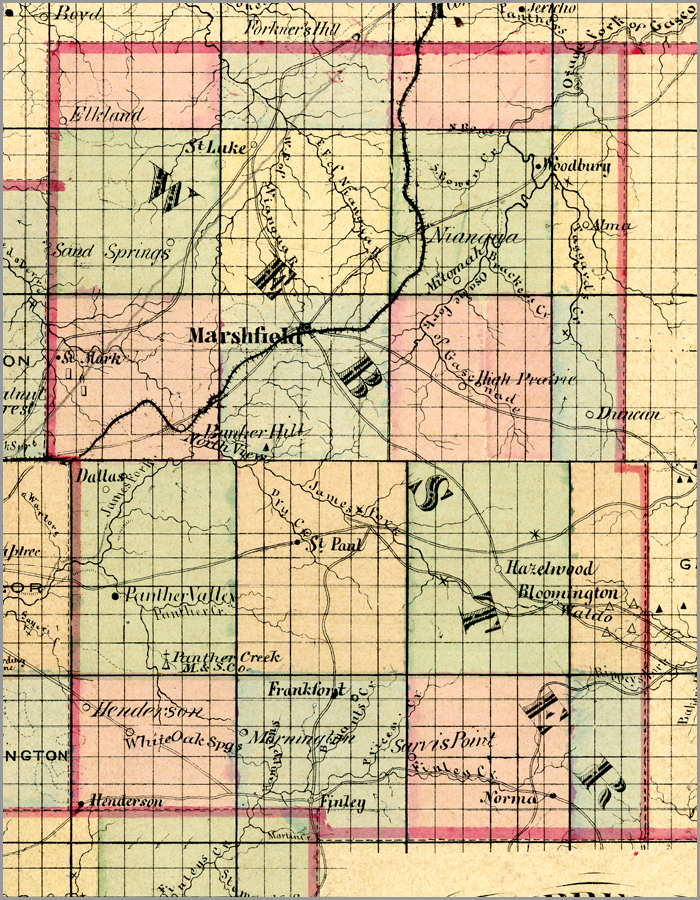Webster County, Missouri

- Formed: March 3, 1855
- County Population 1860: 6,886
- Slave Population 1860: 270
- Civil War Engagements
– Union Fort at Marshfield burned, January 9,
1863
– Union Fort at Sand Springs burned, January
9, 1863
Image courtesy of Wilson’s Creek National Battlefield
The earliest non-Native American settlers in Webster County, Missouri, arrived in the 1830s from Ohio, Pennsylvania, Illinois, Virginia, North Carolina, and other southern states. The oldest settlement is Elkland, formed in 1832, named for the abundant wild game in the area. Webster County is located near the James, Gasconade, and Pomme de Terre Rivers and has natural grazing grasses for cattle, pigs, sheep, horses, and mules. There is abundant timber resources and fertile soil suited for growing oats, wheat, tobacco, corn, beans, and potatoes.
Webster County was officially formed on March 3, 1855. A prominent resident named John F. McMahan named the county after politician Daniel Webster and the county seat, Marshfield, after Webster’s home in Massachusetts. In 1859, the first county newspaper—The Sentinel—was established. By an 1860 census, the population was 6,886 people, with a slave population of 270.
When the Civil War began, most residents did not want to get involved in the conflict. There were very few slaveholders in the county, so there were few strong feelings on the slavery issue. However, after the Confederate victory at Battle of Wilson’s Creek, residents began to choose sides. The Confederate troops began to victimize the residents who supported the Union, and by August of 1861, most pro-Union residents fled to Rolla. They did not return to the area until it was back in Union control.
Webster County men fought in several military regiments, including the 24th, 46th, and 74th Missouri Volunteer Infantries, and the 8th and 16th Missouri Volunteer Cavalries. Over 1,300 Webster County men fought in the Civil War, with only 97 fighting for the Confederacy. The Union gained control of the county in February of 1864 but accidentally burned down the courthouse. There were no major battles in Webster County, though several minor skirmishes resulted over control of area mills. The county was victim to guerrilla warfare and widespread destruction from both armies.
After the war was over, residents who fought returned home and refused to talk about their involvement in the war. Citizens of Webster, regardless of their loyalties during the war, just wanted peace and to regain the life they had before the war. Their decision to remain silent and not discuss the events of the war allowed Webster County to rebuild itself rather quickly. In the early 1870s, fruit orchards began to be very successful in present day Seymour. In the 1880s, the railroad moved into the county and made it a thriving center of dairy, cattle, and poultry industries. Several towns formed due to the population boom that followed the railroad. Niangua formed in 1870. Seymour was formed in 1881, around the remains of a trading post established in the area by Joseph W. McClurg in the 1840s. Both Rogersville and Fordland formed in 1882. By 1870, the railroad helped the population increase to 10,186 people. The area continued to grow steadily in agricultural industries, and also became home to a sizable Amish population in the early 20th century.
 Browse all collections in Webster County
Browse all collections in Webster County
- Consulted:
- Highlights in Webster County History: A Chronological History of the First 150 years. (Marshfield, MO: Webster County Sesquicentennial Historical Subcommittee, 2005).
- History and Families, Webster County, Missouri. (Marshfield, MO: Webster County Historical Society, 1999).
- Webster County, 1860 U.S. Federal Census – Slave Schedules [database on-line]. Provo, UT, USA: Ancestry.com Operations Inc, 2004. Original data: United States of America, Bureau of the Census. Eighth Census of the United States, 1860. Washington, D.C.: National Archives and Records Administration, 1860. M653, 1,438 rolls












